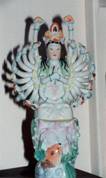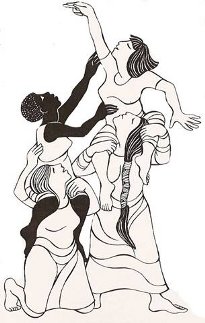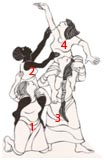Home » Literature Archives » Kanzeon, The Goddess of Mercy, Remixed
Kanzeon, The Goddess of Mercy, Remixed
by Yao Xiang Shakya
-- Maha Prajna Paramita Hridaya Sutra
Kanzeon is the embodiment of mercy and is depicted in art as both male and female. Often the bodhisattva is depicted with many eyes, all needed to see our sorrows; and with many arms and hands that extend to us the tools we need to prevail over adversity.
The Maha Prajna Paramita Hridaya Sutra (the Heart sutra) reveals that the bodhisattva practices "deeply" and in this deep practice was saved from all suffering and distress.
What was this deep practice? What does the Incarnation of Compassion do to be free from misery and distress?
She sees that the Skandhas, the five "heaps of stuff" that we are made of, are not permanent, are not who we really are. Form, feelings, perceptions, impulses and consciousness appear and vanish and are not to be relied upon or regarded as real. They are as real as a dream is real, but they are not true. Kanzeon merely uses these Skandhas to express certain attributes gained from her deep practice.
Kanzeon, is also known as Kwan Yin, Guan Yin or as the male Avalokiteshvara. The images of Kanzeon are ubiquitous. In them She or He is portrayed in various poses many of which suggest a particular spiritual attainment.

Here is a "headless" statue implying mercy is sometimes headless but never heartless.

She is sometimes sitting in a pose of royal ease.

Or with a thousand arms ready to help and give mercy.
The image is the message. In each one the artist communicates a Buddhist teaching. Each one offers a meditation. Each one reflects the Dharma. Kanzeon hears the cries of the world. Her many poses show us her great diversity. She could be either male or female, at ease or in readiness with her sword. How does she manage to be so comprehensive in her service to us?

Kanzeon, The Goddesses © Jiaoyuan Yue
What is often cryptically displayed in the ancient images is disclosed in this modern drawing, Kanzeon, The Goddesses. This image of Kanzeon is female, diverse and distinct. The various poses of the four female figures each suggest a characteristic of the requisites of practice. The collective, cooperative attribute is remarkable: the figures collaborate in their efforts. There is activity and movement as well as stability and structure. Although there are four figures. there is a startling unity to the work. If one is missing or removed the image disintegrates.
Each figure represents a characteristic of deep practice. This deepc practice builds a merciful heart free from feelings, perceptions, impulses and consciousness - but right in form. The heaps of stuff which make us human are employed to raise us upwards.
Kanzeon,The Goddesses draws us in to ask what are the figures telling us? Working together in different poses, each figure availing herself of the assistance of the other, the figures allow us to perceive something higher than the sum of their individual selves.

- Figure 1, Sincera, indicates the fervent request.
- Figure 2. Perpetua, reminds us to maintain continuous attention.
- Figure 3. Peda, tells us to stand on our own two feet.
- Figure 4. Constanta, advises us to keep striving regardless of the distance we must reach.
There is wholeness to this image just as there is wholeness to a practice that leads to mercy. Sometimes one part wanders off and the wholeness is lost and the practice falters. But when practiced together, the effort sustains the reach which is a hand free in space though it is dependent on form, structure, strength, and attention. They are all looking upward.
We, however, tend to become unsure and hesitant. We waver, allowing critical judgments to sneak in; and the mind then topples into confusion. We condemn ourselves and others. We lose our footing or get tired and look elsewhere.
The image reminds us to return the mind to these practice positions. Mercy does not come from sentimental emotions or from following cultural conventions. It comes from deep practice and a perception of reality that goes beyond the critical mind.
Each pose suggests the nature of practice; unfailing kindness comes from strong practice. Liberation is possible when one practices deeply. Each position helps us to remember what is required and what needs to be strengthened.
SinceraThe place of fervent request is on our knees. It is not so easy to kneel. It requires an ardent desire, a need to see again what we have only glimpsed through a tear in the veil of illusion. We know something that we cannot put into words. We've seen that mysterious something for ourselves. The plea to be permitted to see it more clearly comes from this peek into that which we can't explain. The kneeling figure suggests our humility and devotion. We need this kind of commitment if we are to practice deeply.
Historically in the Christian-Judeo tradition, supplication was usually done in a standing posture. As noted in this text from the Catholic Encyclopedia:
In the Jewish Church it was the rule to pray standing, except in time of mourning… the mother of Samuel said, "I am that woman who stood before thee here praying to the Lord." Christ assumes that standing would be the ordinary posture in prayer of those whom He addressed: "And when you shall stand to pray."
The text goes on to say, "when the occasion was one of special solemnity, or the petition very urgent, or the prayer made with exceptional fervor, the Jewish supplicant knelt."
The exceptions are noteworthy. Mourning, solemnity, urgency and fervor brought the supplicant to their knees. Kneeling was and is a universal posture of serious intention. We must ask ourselves if we really mean the words we chant. Do we really want to follow a Path and take responsibility for ourselves, or are we just fooling ourselves?
Sincera, the kneeling one, lifts up Perpetua, continuous attention. We need determination in order to be continuously attentive to what shows up in our mind and in our life. The ability to attend to everything requires physical and spiritual endurance. Under all circumstances the weight of active attention is held up; the request to see and know is held up on our intention, our fervent request.
No matter what arises, we keep our gaze upon it until we can see through it, until we can discern both personal and universal insights.
PerpetuaPerpetua, steadies Peda, the final reach. Perpetua maintains continuous, uninterrupted practice. It turns and returns to the activity of the mind. What are we up to? What are we doing? What is arising? Continuous attention rests on the shoulders of our fervent requests. What we ask for and want is the place where we put our attention. It's that simple.
When we mean it, the strength is there to interrupt the nonstop flow of wandering and wanting something to satisfy our cravings.
We always know that we need to return to our devoted practice. It is not that we return wild with passion but that we use the power of enthusiasm to return our practice to a steady attention. We mean what we say, and we do it. When our mind runs off into fantasy, worry, greed, and delusion, our dedication lifts up a perpetual steadying and restores our practice, over and over again.
When our appeal is genuine it strengthens our attention. We are able to steady the wobble in our concentrated effort.
A robust yet humble lift of attention is required. Sincere, active attention does not weaken with pride of attainment or wither under the faltering of the mind. It goes on, perpetually.
PedaIt is on our own two feet. It is our work, our effort that raises the concentrated mind upward into measureless space.
This stance provides the support we'll need. It comes when we guide our own footsteps and are not detoured by the words of others. When the work is ours, marked with our toes, the Buddha is born. When the practice is our practice it carries us upward.
The upright stance on our own two feet supports and advances. And it is only when we have done the work that we know this to be so. The standing prayer position is not eliminated, nothing is. This position serves to support the effort. It lifts as well as supports.
ConstantaThe practice never fails to reach upward, endlessly and without measure. The Christian teaching of "put your mind on things above" is, in Buddhism, to diminish the power of the Skandhas. We find composure in concentrated effort.
Nirvana is the place of coolness where the Skandhas cannot interfere. Coolness is poise; and composure which comes from the other three figures, humbly requests attention and the knowledge that we are able to go it alone.
We are no longer caught by fancy forms, or irrational emotions or personal consciousness. We may need to look through them but are no longer blinded by their illusions. There is a calm dignity of self-assurance which arises together with our sincere request to awaken, to steady the wobbling mind, to go it alone. These figures are the Kanzeon practice of prajna paramita.
It goes beyond what we can think about or determine with our biased mind. Steady concentration depends on the standing figure. Strong effort remains still and steady. Awakening depends on concentration. It is the regular, steady and unceasing quality of devotion that helps to concentrate the mind.
This image reminds us to reflect on these powerful places of practice, fervent request, and perpetual attention on our own and towards nirvana. If we falter, fade or wane in the practice, we return to Kanzeon:The Goddesses.

